中国文化翻译——中国茶文化1
- 格式:docx
- 大小:18.63 KB
- 文档页数:1
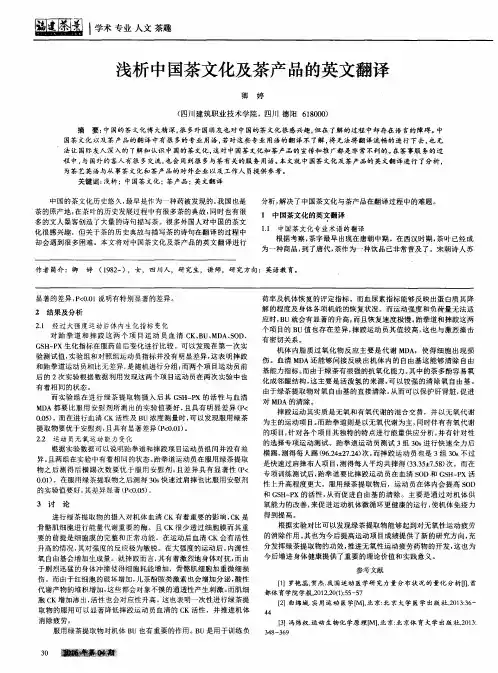
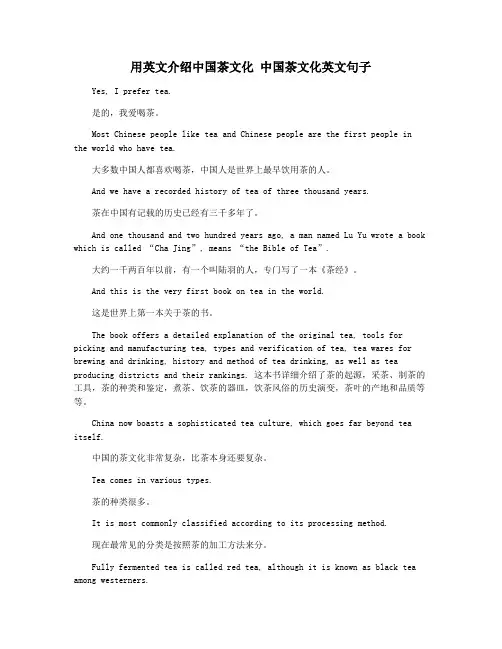
用英文介绍中国茶文化中国茶文化英文句子Yes, I prefer tea.是的,我爱喝茶。
Most Chinese people like tea and Chinese people are the first people in the world who have tea.大多数中国人都喜欢喝茶,中国人是世界上最早饮用茶的人。
And we have a recorded history of tea of three thousand years.茶在中国有记载的历史已经有三千多年了。
And one thousand and two hundred years ago, a man named Lu Yu wrote a book which is called “Cha Jing”, means “the Bible of Tea”.大约一千两百年以前,有一个叫陆羽的人,专门写了一本《茶经》。
And this is the very first book on tea in the world.这是世界上第一本关于茶的书。
The book offers a detailed explanation of the original tea, tools for picking and manufacturing tea, types and verification of tea, tea wares for brewing and drinking, history and method of tea drinking, as well as tea producing districts and their rankings. 这本书详细介绍了茶的起源,采茶、制茶的工具,茶的种类和鉴定,煮茶、饮茶的器皿,饮茶风俗的历史演变,茶叶的产地和品质等等。
China now boasts a sophisticated tea culture, which goes far beyond tea itself.中国的茶文化非常复杂,比茶本身还要复杂。

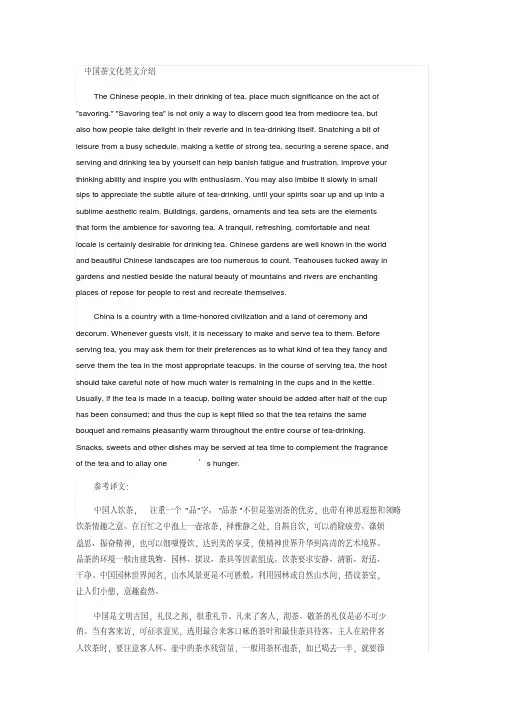
中国茶文化英文介绍The Chinese people, in their drinking of tea, place much significance on the act of "savoring." "Savoring tea" is not only a way to discern good tea from mediocre tea, butalso how people take delight in their reverie and in tea-drinking itself. Snatching a bit of leisure from a busy schedule, making a kettle of strong tea, securing a serene space, and serving and drinking tea by yourself can help banish fatigue and frustration, improve your thinking ability and inspire you with enthusiasm. You may also imbibe it slowly in smallsips to appreciate the subtle allure of tea-drinking, until your spirits soar up and up into a sublime aesthetic realm. Buildings, gardens, ornaments and tea sets are the elementsthat form the ambience for savoring tea. A tranquil, refreshing, comfortable and neatlocale is certainly desirable for drinking tea. Chinese gardens are well known in the world and beautiful Chinese landscapes are too numerous to count. Teahouses tucked away in gardens and nestled beside the natural beauty of mountains and rivers are enchanting places of repose for people to rest and recreate themselves.China is a country with a time-honored civilization and a land of ceremony and decorum. Whenever guests visit, it is necessary to make and serve tea to them. Before serving tea, you may ask them for their preferences as to what kind of tea they fancy and serve them the tea in the most appropriate teacups. In the course of serving tea, the host should take careful note of how much water is remaining in the cups and in the kettle. Usually, if the tea is made in a teacup, boiling water should be added after half of the cup has been consumed; and thus the cup is kept filled so that the tea retains the same bouquet and remains pleasantly warm throughout the entire course of tea-drinking. Snacks, sweets and other dishes may be served at tea time to complement the fragranceof the tea and to allay one’s hunger.参考译文:中国人饮茶,注重一个"品"字。
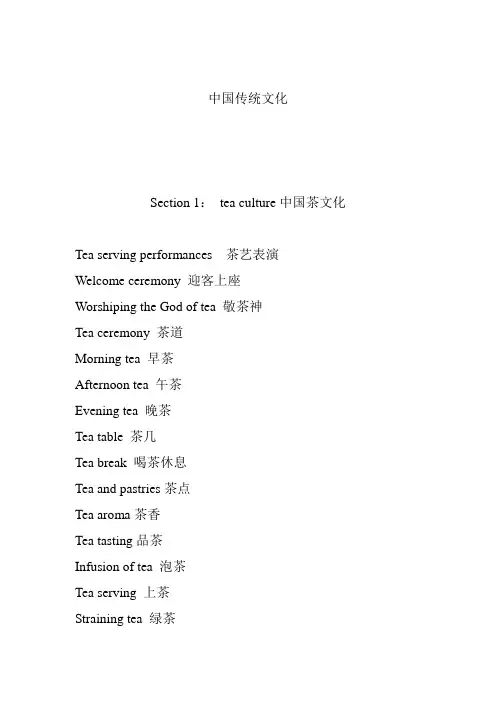
中国传统文化Section 1:tea culture中国茶文化Tea serving performances 茶艺表演Welcome ceremony 迎客上座W orshiping the God of tea 敬茶神Tea ceremony 茶道Morning tea 早茶Afternoon tea 午茶Evening tea 晚茶Tea table 茶几Tea break 喝茶休息Tea and pastries茶点Tea aroma茶香Tea tasting品茶Infusion of tea 泡茶Tea serving 上茶Straining tea 绿茶Sipping tea 呷茶First infusion of tea 头道茶Tea set 茶具Tea tray 茶盘Tea saucer茶碟Ceramic tea pot 紫砂壶Tea container 茶缸Tea caddy 茶叶罐Coaster 茶叶垫Tea strainer 滤茶器Tea spoon 茶匙Section 2:Chinese traditional festival中国传统节日Folkway 社会习俗Firecracker 鞭炮Red couplets 红对联Latern displays 灯盏Dumplings made of sweat rice 汤圆Eight treasure made of sweat rice 八宝饭Sweeping the grave 扫墓Lunar January 正月A portable light 灯笼Lion dance 舞狮Riddle written on latterns 灯谜Give new year’s greatings and visits 拜年Offer sacrifice to ancestors 祭祖Bid farewell to the old year 辞旧岁Family reunion dinner 团圆饭Dinner on New Year’s Eve 午夜饭W orship the moon god 祭月神Bless 祝福Demon 恶魔Lunar calendar农历Section 3 :Chinese ways of preserving health强身健体Barehanded boxing 徒手长拳The wielding of weapons 器械Kicking 踢Hitting 打Throwing 摔Controlling 拿Punching 击Thrusting 刺Fisting 拳打Twisting 扭身Horse stance 马步Bow stance 弓步Self defence 自我防卫External and internal work 内功和外功Self adjustment自我调整Self treatment自我治疗Palm pushing 推掌Requiredt toutine 规定的套路Sword play 剑术Spear play 枪术Reliving rigidity of muscle and joints活动筋骨Promoting the channel 舒经活络Regulating the flow of qi and blood 疏通气血Section 4:Chinese legacies 中国文化遗产Longmen grottoes 河南洛阳龙门石窟Imperial Palace of the Ming and Qing Dynasties 明清皇陵The Mogao carves 敦煌莫高窟Mausoleum of the First Qin Emperor 秦始皇陵Terracotta Warriors and Horses 兵马俑Beijing Forbidden City 北京紫禁城The temple of heaven in beijing 北京天坛Zhoukoudian site of peking man 周口店北京人遗址Dujiang weirs and qingchengshan mountain in sichuan province 四川都江堰和青城山Jiuzhaigou senic spot in sichuan province 四川九寨沟风景名胜区Wulingyuan tourist site in hunan 湖南武陵源风景名胜区Chengde summer resort and temples 承德避暑山庄Potala palace 西藏布达拉宫。
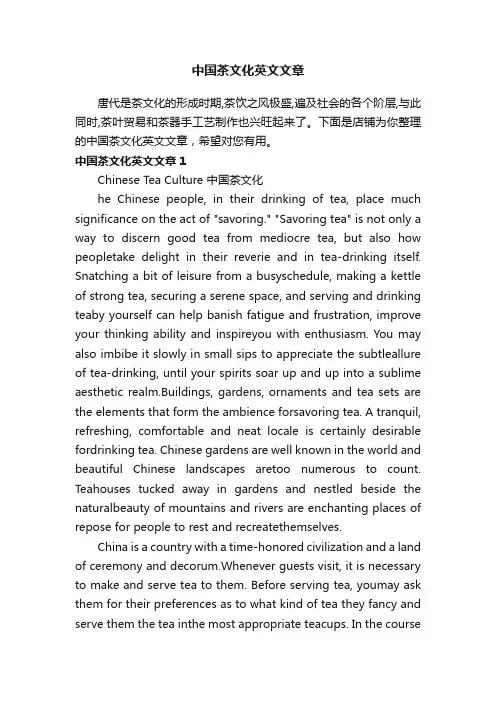
中国茶文化英文文章唐代是茶文化的形成时期,茶饮之风极盛,遍及社会的各个阶层,与此同时,茶叶贸易和茶器手工艺制作也兴旺起来了。
下面是店铺为你整理的中国茶文化英文文章,希望对您有用。
中国茶文化英文文章1Chinese Tea Culture 中国茶文化he Chinese people, in their drinking of tea, place much significance on the act of "savoring." "Savoring tea" is not only a way to discern good tea from mediocre tea, but also how peopletake delight in their reverie and in tea-drinking itself. Snatching a bit of leisure from a busyschedule, making a kettle of strong tea, securing a serene space, and serving and drinking teaby yourself can help banish fatigue and frustration, improve your thinking ability and inspireyou with enthusiasm. You may also imbibe it slowly in small sips to appreciate the subtleallure of tea-drinking, until your spirits soar up and up into a sublime aesthetic realm.Buildings, gardens, ornaments and tea sets are the elements that form the ambience forsavoring tea. A tranquil, refreshing, comfortable and neat locale is certainly desirable fordrinking tea. Chinese gardens are well known in the world and beautiful Chinese landscapes aretoo numerous to count. Teahouses tucked away in gardens and nestled beside the naturalbeauty of mountains and rivers are enchanting places of repose for people to rest and recreatethemselves.China is a country with a time-honored civilization and a land of ceremony and decorum.Whenever guests visit, it is necessary to make and serve tea to them. Before serving tea, youmay ask them for their preferences as to what kind of tea they fancy and serve them the tea inthe most appropriate teacups. In the courseof serving tea, the host should take careful noteof how much water is remaining in the cups and in the kettle. Usually, if the tea is made in ateacup, boiling water should be added after half of the cup has been consumed; and thus thecup is kept filled so that the tea retains the same bouquet and remains pleasantly warmthroughout the entire course of tea-drinking. Snacks, sweets and other dishes may be servedat tea time to complement the fragrance of the tea and to allay one's hunger.中国人饮茶,注重一个“品”字。
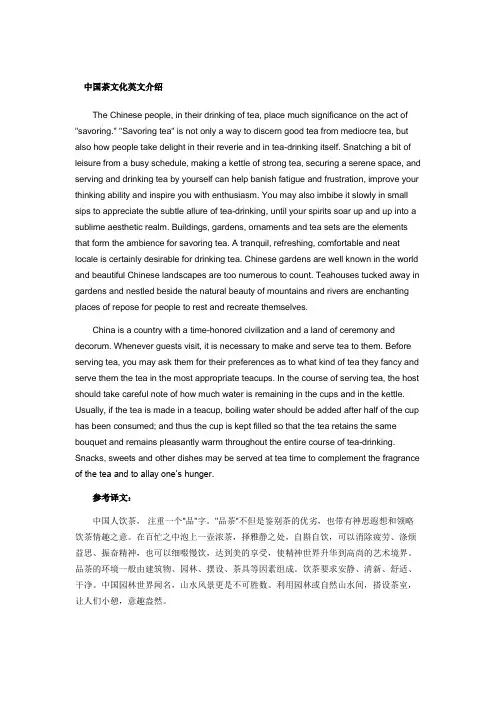
中国茶文化英文介绍The Chinese people, in their drinking of tea, place much significance on the act of "savoring." "Savoring tea" is not only a way to discern good tea from mediocre tea, but also how people take delight in their reverie and in tea-drinking itself. Snatching a bit of leisure from a busy schedule, making a kettle of strong tea, securing a serene space, and serving and drinking tea by yourself can help banish fatigue and frustration, improve your thinking ability and inspire you with enthusiasm. You may also imbibe it slowly in small sips to appreciate the subtle allure of tea-drinking, until your spirits soar up and up into a sublime aesthetic realm. Buildings, gardens, ornaments and tea sets are the elements that form the ambience for savoring tea. A tranquil, refreshing, comfortable and neat locale is certainly desirable for drinking tea. Chinese gardens are well known in the world and beautiful Chinese landscapes are too numerous to count. Teahouses tucked away in gardens and nestled beside the natural beauty of mountains and rivers are enchanting places of repose for people to rest and recreate themselves.China is a country with a time-honored civilization and a land of ceremony and decorum. Whenever guests visit, it is necessary to make and serve tea to them. Before serving tea, you may ask them for their preferences as to what kind of tea they fancy and serve them the tea in the most appropriate teacups. In the course of serving tea, the host should take careful note of how much water is remaining in the cups and in the kettle. Usually, if the tea is made in a teacup, boiling water should be added after half of the cup has been consumed; and thus the cup is kept filled so that the tea retains the same bouquet and remains pleasantly warm throughout the entire course of tea-drinking. Snacks, sweets and other dishes may be served at tea time to complement the fragrance of the tea and to allay one’s hunger.参考译文:中国人饮茶,注重一个"品"字。
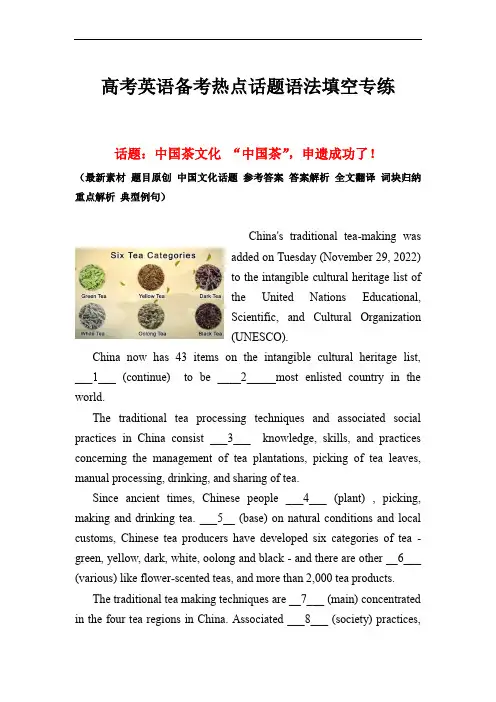
高考英语备考热点话题语法填空专练话题:中国茶文化“中国茶”,申遗成功了!(最新素材题目原创中国文化话题参考答案答案解析全文翻译词块归纳重点解析典型例句)China's traditional tea-making wasadded on Tuesday (November 29, 2022)to the intangible cultural heritage list ofthe United Nations Educational,Scientific, and Cultural Organization(UNESCO).China now has 43 items on the intangible cultural heritage list, ___1___ (continue) to be ____2_____most enlisted country in the world.The traditional tea processing techniques and associated social practices in China consist ___3___ knowledge, skills, and practices concerning the management of tea plantations, picking of tea leaves, manual processing, drinking, and sharing of tea.Since ancient times, Chinese people ___4___ (plant) , picking, making and drinking tea. ___5__ (base) on natural conditions and local customs, Chinese tea producers have developed six categories of tea -green, yellow, dark, white, oolong and black - and there are other __6___ (various) like flower-scented teas, and more than 2,000 tea products.The traditional tea making techniques are __7___ (main) concentrated in the four tea regions in China. Associated ___8___ (society) practices,however, are spread throughout the country ___9__ shared by multiple ethnic groups.Tea is found everywhere in Chinese people's daily life, as dipped or boiled tea __10___ (serve) in families, workplaces, tea houses, restaurants and temples, to name a few. It is also an important part of socialization and ceremonies such as weddings and sacrifices.【参考答案】1.continuing2.the3.of4.have been planting5.Based6.varieties7.mainly8.social9.and 10.is served【答案解析】1.continuing 考查非谓语动词的现在分词。
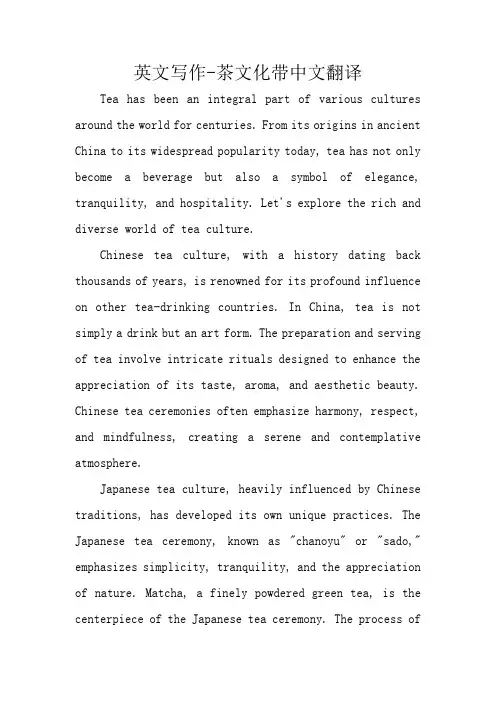
英文写作-茶文化带中文翻译Tea has been an integral part of various cultures around the world for centuries. From its origins in ancient China to its widespread popularity today, tea has not only become a beverage but also a symbol of elegance, tranquility, and hospitality. Let's explore the rich and diverse world of tea culture.Chinese tea culture, with a history dating back thousands of years, is renowned for its profound influence on other tea-drinking countries. In China, tea is not simply a drink but an art form. The preparation and serving of tea involve intricate rituals designed to enhance the appreciation of its taste, aroma, and aesthetic beauty. Chinese tea ceremonies often emphasize harmony, respect, and mindfulness, creating a serene and contemplative atmosphere.Japanese tea culture, heavily influenced by Chinese traditions, has developed its own unique practices. The Japanese tea ceremony, known as "chanoyu" or "sado," emphasizes simplicity, tranquility, and the appreciation of nature. Matcha, a finely powdered green tea, is the centerpiece of the Japanese tea ceremony. The process ofpreparing and serving matcha involves precise movements and gestures, showcasing the beauty of minimalism and attention to detail.In India, tea holds a significant cultural and social importance. Masala chai, a spiced tea blend, is a popular choice in Indian households. Tea is not only enjoyed as a refreshing beverage but also serves as a catalyst for social gatherings and discussions. The concept of "chai pe charcha," meaning "tea and conversation," reflects the role of tea as a facilitator of connections and conversations among people.Tea culture is not limited to East Asia and India. In the United Kingdom, the tradition of afternoon tea holds a special place. It is a cherished ritual that typically involves tea served with scones, finger sandwiches, and pastries. The British take pride in their tea etiquette, with proper teapot pouring techniques and the use of fine china.No matter where tea culture is embraced, it promotes a sense of relaxation, mindfulness, and social interaction. Whether it is a formal ceremony or a casual gathering with friends, tea offers a moment of pause in our busy lives,allowing us to appreciate the simple pleasures and connect with others.中文翻译为:茶在世界各地的文化中已经有数百年的历史,它不仅成为一种饮料,更是优雅、宁静和热情待客的象征。
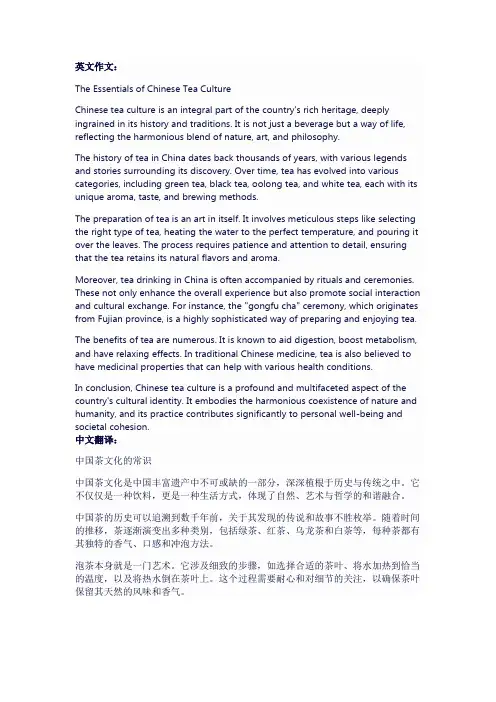
英文作文:The Essentials of Chinese Tea CultureChinese tea culture is an integral part of the country's rich heritage, deeply ingrained in its history and traditions. It is not just a beverage but a way of life, reflecting the harmonious blend of nature, art, and philosophy.The history of tea in China dates back thousands of years, with various legends and stories surrounding its discovery. Over time, tea has evolved into various categories, including green tea, black tea, oolong tea, and white tea, each with its unique aroma, taste, and brewing methods.The preparation of tea is an art in itself. It involves meticulous steps like selecting the right type of tea, heating the water to the perfect temperature, and pouring it over the leaves. The process requires patience and attention to detail, ensuring that the tea retains its natural flavors and aroma.Moreover, tea drinking in China is often accompanied by rituals and ceremonies. These not only enhance the overall experience but also promote social interaction and cultural exchange. For instance, the "gongfu cha" ceremony, which originates from Fujian province, is a highly sophisticated way of preparing and enjoying tea. The benefits of tea are numerous. It is known to aid digestion, boost metabolism, and have relaxing effects. In traditional Chinese medicine, tea is also believed to have medicinal properties that can help with various health conditions.In conclusion, Chinese tea culture is a profound and multifaceted aspect of the country's cultural identity. It embodies the harmonious coexistence of nature and humanity, and its practice contributes significantly to personal well-being and societal cohesion.中文翻译:中国茶文化的常识中国茶文化是中国丰富遗产中不可或缺的一部分,深深植根于历史与传统之中。
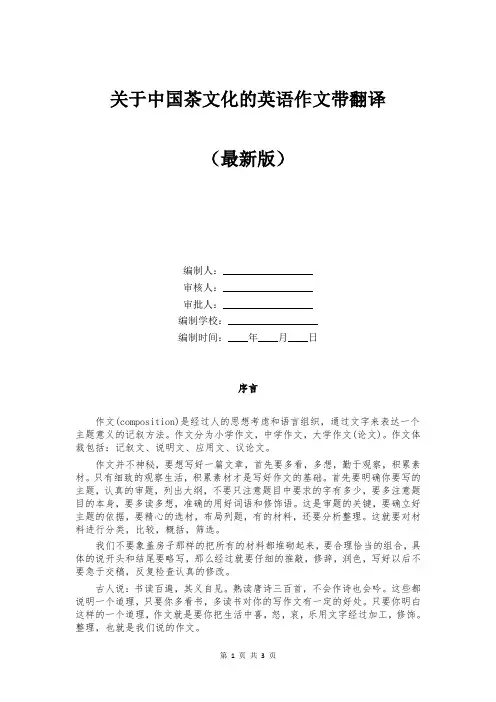
关于中国茶文化的英语作文带翻译(最新版)编制人:__________________审核人:__________________审批人:__________________编制学校:__________________编制时间:____年____月____日序言作文(composition)是经过人的思想考虑和语言组织,通过文字来表达一个主题意义的记叙方法。
作文分为小学作文,中学作文,大学作文(论文)。
作文体裁包括:记叙文、说明文、应用文、议论文。
作文并不神秘,要想写好一篇文章,首先要多看,多想,勤于观察,积累素材。
只有细致的观察生活,积累素材才是写好作文的基础。
首先要明确你要写的主题,认真的审题,列出大纲,不要只注意题目中要求的字有多少,要多注意题目的本身,要多读多想,准确的用好词语和修饰语。
这是审题的关键,要确立好主题的依据,要精心的选材,布局列题,有的材料,还要分析整理。
这就要对材料进行分类,比较,概括,筛选。
我们不要象盖房子那样的把所有的材料都堆砌起来,要合理恰当的组合,具体的说开头和结尾要略写,那么经过就要仔细的推敲,修辞,润色,写好以后不要急于交稿,反复检查认真的修改。
古人说:书读百遍,其义自见。
熟读唐诗三百首,不会作诗也会吟。
这些都说明一个道理,只要你多看书,多读书对你的写作文有一定的好处。
只要你明白这样的一个道理,作文就是要你把生活中喜,怒,哀,乐用文字经过加工,修饰。
整理,也就是我们说的作文。
作文内容关于中国茶文化的英语作文带翻译篇一:中国茶文化In China, tea has a very long history, and has formed a Chinese tea culture. At the same time, tea is good for our health and is loved by many people. Chinese tea culture is broad and profound. It includes not only material culture, but also profound spiritual civilization. Talking about Chinese tea. Can be traced back to ancient times, it is from the Tang Dynasty and Song Dynasty flourished.From then on, the spirit of tea permeated the court and society, and went deep into Chinese poetry, painting, calligraphy, religion and medicine. For thousands of years, China has accumulated a large number of tea cultivation and production of material culture, but also enriched the spiritual culture of tea.【参考译文】在中国,茶具有非常悠久的历史,并且已经形成了中国茶文化。
1、八大菜系原文:中国一个幅员辽阔、资源丰富、历史悠久的多民族国家,每个民族都有其独特的丰富菜肴。
地域菜系在地理环境、气候、文化传统、民族风俗和其他因素的影响下经过悠久历史的发展已经成形。
最有影响力、最具代表性的是鲁、川、粵、闽、苏、浙、湘、徽菜系,这八种被人们称为“八大菜系”。
中国的“八大菜系”是以多种多样的烹饪方法区分的,各有其长处。
参考译文:Eight Major CuisinesChina is a time-honored multi-ethnics nation with a vast territory and abundant resources, and every ethnic group has its unique abundant dishes. Regional cuisines have taken shape after long-history evolution under the influence of geographical environment, climate, cultural tradition, folk customs and other factors. The most influential and representative ones are Lu, Chuan,Yue, Min, Su,Zhe, Xiang and Hui Cuisines, which are commonly known as “Eight Major Cuisines”. Dishes in the “Eight Major Cuisines”in China are characterized by diversified cooking skills, with each having its strong points.2、中国茶文化原文:中国是一个文化历史悠久的(time-honored)国度,也是一个礼仪(ceremony anddecorum)之邦。
热点07 世界非遗中国茶文化1.中国的茶是世界上最受欢迎的饮品之一,假如你叫李华,你的学校正在举行用英语讲好中国故事的比赛,请围绕茶的历史、种类、加工、饮茶、益处等方面,根据下面的思维导图,以“Chinese Tea Culture”为题,写一篇英语短文。
要求:1. 语言表达准确,短文连贯、通顺;2. 短文应包括所有提示内容,可适当发挥,不要逐字翻译;3. 词数80左右,开头和结尾已给出,不计入总词数。
Chinese Tea CultureGood morning! Ladies and gentleman. My name is Li Hua. I am happy to share my topic with you here. Chinese tea is one of the most popular drinks in the world.____________________________________________________________________________________________ ____________________________________________________________________________________________ ____________________________________________________________________________________________ ___________________________________________________________Come to enjoy Chinese tea culture. Maybe, you will like it.【参考范文】Chinese Tea CultureGood morning! Ladies and gentleman. My name is Li Hua. I am happy to share my topic with you here. Chinese tea is one of the most popular drinks in the world.Chinese people have liked drinking tea since ancient times. Tea has a history of over 4000 years since the Chinese began to grow and drink tea. There are many kinds of tea in China, such as green tea, black tea, oolong tea and so on. Longjing Tea is famous all over the world. People use tea pots or tea cups to drink tea. They are made of ceramics.Drinking tea is good for health. It’s said that green tea can prevent cancer. When you are tired, a cup of tea can help you relax.Come to enjoy Chinese tea culture. Maybe, you will like it.【详解】[总体分析]①题材:本文是一篇说明文;①时态:本文采用“一般现在时”;①提示:要求包含所有提示内容,并适当发挥。
The Richness and Depth of Chinese TeaCultureTea, a beverage that has been integral to Chinese culture for centuries, embodies not only the art of taste but also the essence of harmonious living. It is a symbol of refinement, peace, and respect, often used as a medium for social interaction and personal reflection. Theintricate process of tea preparation, from selecting the right leaves to mastering the pouring techniques, reflects the profound philosophy and attention to detail that characterize Chinese culture.The selection of tea is as diverse as it is delicate. There are six major types of tea in China: green, black, white, yellow, oolong, and post-fermented tea, each withits unique flavor, aroma, and brewing method. Green tea,for instance, is associated with freshness and a slightly bitter aftertaste, while black tea offers a richer, more robust flavor. White tea is prized for its delicate aroma and subtle taste, while oolong tea offers a balance between the two.The art of brewing tea is as much about mastering the techniques as it is about understanding the nature of the leaves. The water temperature, the amount of tea used, and the duration of steeping all play crucial roles in extracting the flavor and aroma of the tea. Each step in the process, from warming the teapot to pouring the tea, is executed with precision and care, reflecting the respectfor the leaves and the attention to detail that is a hallmark of Chinese culture.Beyond its practical value, tea in China is also deeply rooted in spiritual and philosophical traditions. Tea ceremonies, such as the Zen tea ceremony in Japan, are not just about drinking tea; they are about connecting with oneself, with others, and with the universe. They are a way of life that promotes inner peace, harmony, and respect for nature and fellow beings.Tea is also a powerful medium for social interaction. Gatherings around the tea table are a common occurrence in Chinese culture, whether it's a formal tea ceremony or a casual get-together with friends. Sharing a cup of tea is not just about tasting the beverage; it's about sharingthoughts, feelings, and experiences. It's a way of connecting with others and building relationships based on mutual respect and understanding.In conclusion, Chinese tea culture is a rich and profound expression of Chinese culture that goes beyondtaste and aroma to embrace harmony, respect, andspirituality. It is a testament to the attention to detail, respect for tradition, and appreciation for the simple pleasures of life that have characterized Chinese culturefor centuries. As we enjoy a cup of tea, we are not just tasting a beverage; we are experiencing a centuries-old tradition that continues to inspire and enrich our lives.**中国茶文化的丰富与深邃**茶,这一在中国文化中占据重要地位的饮品,不仅体现了品味的艺术,更体现了和谐生活的精髓。
茶文化英文介绍标准化管理处编码[BBX968T-XBB8968-NNJ668-MM9N]中国茶文化英文介绍The Chinese people, in their drinking of tea, place much significance on the act of "savoring." "Savoring tea" is not only a way to discern good tea from mediocre tea, but also how people take delight in their reverie and in tea-drinking itself. Snatching a bit of leisure from a busy schedule, making a kettle of strong tea, securing a serene space, and serving and drinking tea by yourself can help banish fatigue and frustration, improve your thinkingability and inspire you with enthusiasm. You may also imbibe it slowly in small sips to appreciate the subtle allure of tea-drinking, until your spirits soar up and up into a sublime aesthetic realm. Buildings, gardens, ornaments and tea sets are the elements that form the ambience for savoring tea. A tranquil, refreshing, comfortable and neat locale is certainly desirable for drinking tea. Chinese gardens are well known in the world and beautiful Chinese landscapes are too numerous to count. Teahouses tucked away in gardens and nestled beside the natural beauty of mountains and rivers are enchanting places of repose for people to rest and recreate themselves.China is a country with a time-honored civilization and a land of ceremony and decorum. Whenever guests visit, it is necessary to make and serve tea to them. Before serving tea, you may ask them for their preferences as to what kind of tea they fancy and serve them the tea in the most appropriate teacups. In the course of serving tea, the host should take careful note of how much water is remaining in the cups and in the kettle. Usually, if the tea is made in a teacup, boiling water should be added after half of the cup has been consumed; and thus the cup is kept filled so that the tea retains the same bouquet and remains pleasantly warm throughout the entire course of tea-drinking. Snacks, sweets and other dishes may be served at tea time to complement the fragrance of the tea and to allay one’s hunger.参考译文:中国人饮茶,注重一个"品"字。
The Richness and Depth of Chinese TeaCultureTea, a beverage that has been a part of Chinese culture for thousands of years, is not just a drink but an embodiment of tradition, art, and philosophy. The Chinese tea culture is an intricate tapestry of rituals, ceremonies, and tastes that reflect the harmonious blend of nature and humanity. From the meticulous selection of teas to the elegant tea sets and the serene atmosphere in which theyare consumed, every detail is carefullyconsidered,reflecting the deep respect for this ancient beverage.The history of Chinese tea dates back to the ancient times, with legends tracing its origins to the legendary Emperor Shen Nong, who is believed to have discovered tea while searching for medicinal herbs. Over the centuries,tea has evolved from a medicinal plant to a highly prized commodity, traded across the Silk Road and eventually becoming a symbol of Chinese civilization and refinement.There are six major types of teas in China: green, oolong, black, white, yellow, and pu-erh. Each type has itsunique flavor, aroma, and brewing method. Green teas, for instance, are known for their refreshing and slightlybitter taste, while oolong teas offer a complex blend of floral and fruity notes. Black teas are rich and malty, while white teas are delicate and sweet. Yellow and pu-erh teas have their own unique characteristics, making each type a unique experience.The preparation of tea is an art in itself. The water temperature, the amount of tea leaves, and the steeping time all play crucial roles in extracting the perfect flavor. The tea ceremony, or "chanoyu," is an elaborate ritual that involves the careful handling of tea utensils, the appreciation of the tea's aroma and color, and the sharing of the brewed tea with guests. This ceremony is not just about drinking tea; it's about creating a serene and harmonious atmosphere where people can relax, communicate, and appreciate the finer things in life.The Chinese tea culture is also deeply connected to Zen Buddhism. Many temples and monasteries have their own tea gardens, where monks cultivate and harvest tea leaves. The act of making and drinking tea is often seen as a way toachieve inner peace and tranquility, a reflection of the Zen philosophy of "wu" or "nothingness."In modern times, the popularity of tea has spread beyond China, with tea houses and tea ceremonies becoming popular in many countries. However, the essence of Chinese tea culture remains unchanged: it is a way of life that combines taste, tradition, and spirituality. It is a celebration of nature's bounty and a reminder of the simple pleasures that can be found in everyday life.**中国茶文化的丰富与深邃**茶,这一在中国文化中流传了数千年的饮品,不仅仅是一种饮料,更是传统、艺术和哲学的体现。
中国茶文化:一杯清茗,千年传承Tea, a beverage that has been enjoyed by the Chinesefor thousands of years, is not just a drink but a culture.It embodies the essence of Chinese civilization, reflecting its history, philosophy, and art. From the meticulous preparation of tea leaves to the artful pouring of tea into a delicate cup, every step of the tea ceremony is filledwith symbolism and tradition.The history of tea in China dates back to ancient times, with records showing that it was first discovered by the Emperor Shen Nong in the 3rd century BC. Since then, teahas been cultivated, processed, and consumed in various forms, becoming a staple in Chinese households. Tea wasalso traded extensively along the Silk Road, introducing it to other cultures and eventually leading to the development of diverse tea cultures around the world.The art of tea making, known as "Cha Dao" in Chinese,is a highly skilled craft that requires meticulousattention to detail. The selection of tea leaves, thequality of water, the temperature at which the tea is brewed, and the way it is poured into the cup allcontribute to the final flavor and aroma of the tea. Theact of making and drinking tea is also a form of meditation, allowing the drinker to connect with their inner selves and appreciate the simple pleasures of life.In addition to its practical uses, tea has also playeda significant role in Chinese philosophy and literature. Many ancient philosophers and writers used tea as a mediumto explore and express their thoughts and feelings. Tea was seen as a symbol of purity and tranquility, often used to describe the ideal state of mind. In modern times, tea has also become a popular topic in poetry, novels, and art, further highlighting its cultural significance.The types of tea vary widely in China, with each region producing its unique variety. From the green teas of Zhejiang and Fujian to the black teas of Anhui and Yunnan, each type of tea has its own unique flavor and aroma. Teais also consumed in a variety of ways, including being brewed directly in a teapot, infused with flowers or fruits, or used in cooking and baking.In conclusion, Chinese tea culture is not just about drinking tea; it is about experiencing a way of life thatcombines art, philosophy, and tradition. The act of making and drinking tea is a way of connecting with nature, history, and culture, allowing us to appreciate the simple yet profound pleasures that life has to offer. As the world becomes increasingly globalized, the beauty and wisdom of Chinese tea culture continue to inspire and influence people around the globe.**中国茶文化:一杯清茗,千年传承**茶,这一被中国人享用了数千年的饮品,不仅仅是一种饮料,更是一种文化。
中国的茶叶艺术博大精神,并且渊源流长。
很早以前人们就发
现饮茶可以说是是人们每日必不可少的饮品,它可以使人神清
气爽,精神百倍。
茶共有六种:绿茶,黑茶,黄茶,白茶,乌
龙茶,花茶和普洱茶。
由于中国地势广阔,所以每个地域都可
以说有特殊的茶种。
中国不愧是茶叶的发源地。
现在世界的茶
叶起初都是由中国传入。
中国的茶文化同她的历史一样悠久。
The Chinese tea is broad and profound ,and it has a long history. Long time ago, people found tea can make people spirited and think clearly, so it became one of seven daily necessities. There are six kinds of tea, namely Green tea, Black tea, Yellow tea, White tea, Oolong tea, Flower tea and Puer tea. Each part of China has its own special type of tea. China is truly the hometown of tea. All tea used in the world now are from China originally. Chinese tea culture has the same long history as Chinese culture. In this paper, I will summarize something about the tea history and the use for people's health, and point out why Chinese look tea as one of the three famous drink in the world. Key words: Tea; history; health ;Culture ; Chinese。